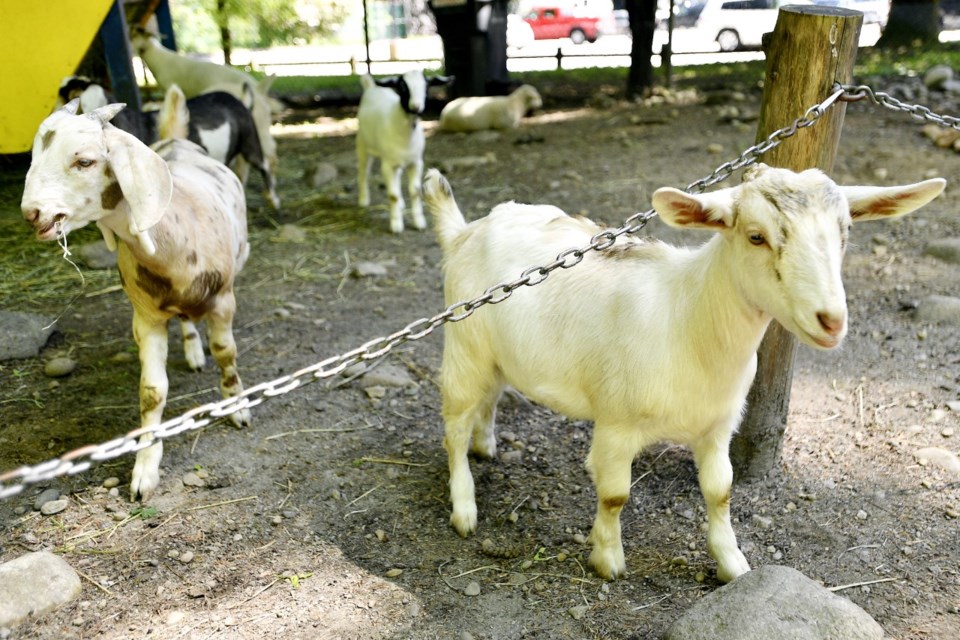So long goats, hello mushroom wall?
A mushroom wall is among the ideas being proposed for the former petting farm space in Queen’s Park, which was the summertime home for goats, rabbits and other animals prior to the pandemic.
Erika Mashig, the city’s manager of parks and open space planning, design and construction, said staff will be reporting back to council in March with a preferred option for the Queen’s Park petting farm master plan, as well as the public consultation that drove the development of that plan.
“It will also speak to a phasing plan and cost for each of the phases to transform the farm. We won't be doing it all at once, but in a logical sequence,” she said. “It involves repurposing of some of the structures within the farm, as well as, I should say, a succession of planting and habitat that will take time to implement and grow into itself.”
During the last round of public engagement, the city presented two concepts for feedback. Both concepts include opportunities for play, educational programming, and places to gather and socialize.
- The Habitat concept focuses on where plants and animals live, and get food and water. This concept includes a pollinator meadow (attracting pollinators), shrubs and smaller forest planting (supporting animal diversity) and wetland area (providing food, shelter and nesting area for birds and other animals).
- The Grow concept focuses on plants that are edible and grow well in the shady forest environment. It envisions plantings that encourage exploration and educate visitors about food, medicinal plants and responsible harvesting.
Budget impacts
Plans for the former petting farm space were discussed during a recent workshop about the city’s capital budget.
Coun. Daniel Fontaine said he’s also fielded questions from citizens, who have asked what will grow in that part of the park, given that there is little sunlight in that “very forested” part of the park.
“Unless we're growing mushrooms or things that perhaps don't require … a lot of sunlight?” he said.
As it turns out, mushrooms are part of the plan for that part of the park.
“Mushrooms are actually a part of the concept— growing mushrooms,” Mashig said. “A mushroom wall, we are very excited about it.”
Fontaine said the city is budgeting $159,897 in 2023 as part of a process to change “a much cherished location in our community” into a space that demonstrates the city’s commitment to sustainability. Noting that an additional $350,000 is allocated in the 2027 capital budget, he sought clarification from staff about the use of the funds.
Mashig said the $159,000 is for further consulting fees to provide design development and construction drawings for Phase 1 of the transition of the farm, and the $350,000 budgeted for in 2027 is for a future phase of the implementation of the farm’s transition.
Fontaine questioned if the city had considered what it would cost to remove the zoo structures and return that land back to park space.
Dean Gibson, the city’s director of parks and recreation, said the city hasn’t done that analysis, so further work would be required to determine what would need to be done to reinstate that area as natural parkland.
“For clarity, the funding that is there is not for the removal of any of the existing structures, but it is more of an adaptation of some of those structures to respond to the program that has come up through the public engagement process for the past several years,” he said.
Fontaine said he’s also been approached by several community members who have said there are many sustainability programs offered in the school system, and he questioned if this was a repetition of successful programs.
Mashig said the city sees the farm space in Queen’s Park a really unique opportunity —maybe more unique than some of the school programs that are happening—because of its environment. She said the site is part of an urban forest, which lends itself to initiatives, such as foraging of edible things growing in the natural forest environment.
“Those are the kinds of programming and education that we want to bring to urban kids,” she said. “And we think Queen's Park is a great opportunity.”
Mashig said the petting farm space would be part of a bigger system within Queen's Park, which includes the city’s greenhouses, a tree farm, a pollinator pasture and bee hotels.
“There is a system within Queen's Park that we really think we can create an educational centre within the Queen's Park farm space,” she said.
Why no animals?
According to the City of New Westminster, the Queen’s Park petting farm opened in 1960, and animal welfare practices have changed since that time.
“The current space is no longer adequate for the type of livestock that are housed in farm each season,” said the city’s engagement website, BeHeardNewWest. “Additionally, the number of visitors to the farm has increased substantially over the years creating increased stress on the animals.”
When the petting farm didn’t open in the summer of 2020 because of COVID-19 restrictions, the city took it as an opportunity to begin exploring a new vision for the farm.
In late 2021, city council approved a staff recommendation to transition the Queen’s Park petting farm space away from livestock towards a re-imagined future that focuses on sustainability. The city has since hired a consultant to develop a concept plan for the space and engaged with the community about the project.
📢 SOUND OFF: What would you like to see done in the Queen's Park former farm space? Will you miss the animals? Do you like the new focus on sustainable growing? Share your thoughts — send us a letter.





